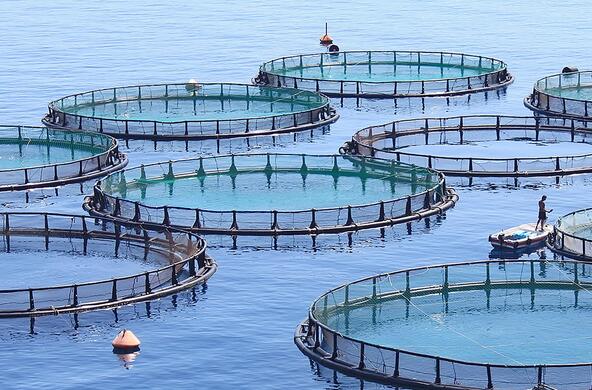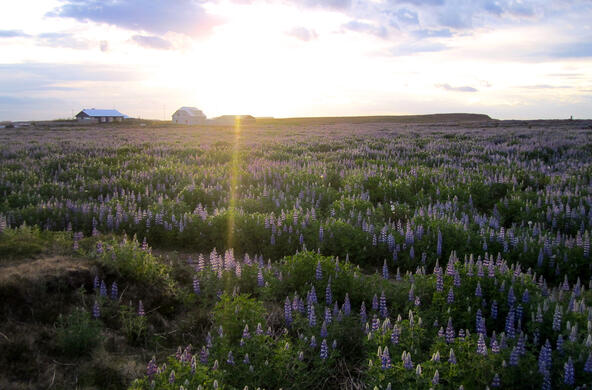Toxic groundwater, massive fish-kills, and thinning ozone. What is the common link between these environmental problems? The answer may be too much nitrogen in the environment–produced and distributed worldwide as fertilizer and by burning fossil fuels.
Fertilizer
Look at any bag of garden fertilizer and you will find three numbers, for instance 15-4-5, that indicate the content of nitrogen, phosphorus, and potassium. The first number, which is the percentage of nitrogen, is usually the largest. Most soils contain relatively small amounts of nitrogen, so adding nitrogen fertilizer is a good way to make plants grow faster.
Why is nitrogen so important to the nutrition of plants and animals? Nitrogen is an essential constituent in the proteins and the genetic material (DNA) of all organisms. Growth in plants is directly related to the nitrogen content in their leaves. When animals eat plants, they convert the nitrogen in plants to the nitrogen contained in animal protein. In fact, human tissue is nearly all protein and contains about 5% nitrogen by weight. Thus, all life on Earth depends on the amount of nitrogen that is available in soils for plants to grow.
Nitrogen: Reactive or Unreactive?
The low content of nitrogen in most soils exists in stark contrast to the abundance of nitrogen in air, where it accounts for 78% of Earth’s atmosphere. How can plants be simultaneously starved for nitrogen in the soil when they are bathed in an atmosphere that is so rich in nitrogen? Atmospheric nitrogen is found as a molecule containing two nitrogen atoms joined by one of the strongest chemical bonds known in nature. The atoms in atmospheric nitrogen (N2) are so attracted to each other that it is nearly impossible for them to react with any other substance on Earth. For nitrogen to be useful to plant growth it must be converted from N2 to one of several forms in which the nitrogen is bonded to hydrogen (e.g., NH4+) or oxygen (e.g., NO3–) that plants can assimilate.
By far the most important natural source of reactive (or fixed) nitrogen derives from the activity of certain bacteria that convert atmospheric N2 to ammonia (NH3). Some of these bacteria are widespread in soils, where they feed on dead organic materials. Other nitrogen-fixing bacteria are found growing in association with the roots of higher plants. We all depend on the activity of these tiny soil organisms, which add about 140 million tons of nitrogen to soils each year. Many farmers grow crops, like soybeans, which harbor nitrogen-fixing bacteria in their roots, to supplement the meager supply of nitrogen in soils.
Fertilizer Production
In the early 1900s, chemists in Germany discovered how to produce fixed nitrogen in the laboratory. Their discovery allows humans to duplicate the reaction performed by soil bacteria. The process requires lots of energy, but given that most agricultural crops grow so much faster with added nitrogen, synthetic fertilizer is often a good investment for most farmers. After World War II, the production and use of synthetic nitrogen fertilizer sky-rocketed throughout the world. Today, many farms in the central U.S. regularly apply as much as 200 lbs of nitrogen fertilizer per acre of land each year. The total production of nitrogen fertilizer now amounts to more than 100 million tons–nearly as much as the total amount of fixed nitrogen produced by soil bacteria worldwide.
Fertilizer has dramatically increased crop yields and the availability of food for humans throughout the world. But the widespread use of fertilizer has produced a number of environmental problems. One problem stems from the volatilization of ammonia from fertilizer, because ammonia in the atmosphere is a precursor for fine particles, which are a human health hazard. Ammonia also escapes to the atmosphere from various livestock and poultry farms, where it is emitted from animal wastes. As the popularity of confined animal feeding operations (CAFOs) has increased in recent years, so have these emissions of ammonia, which can be traced to the nitrogen in feed crops.
Other environmental problems from fertilizer nitrogen stem from the activities of soil bacteria that transform nitrogen from one form to another. For instance, ammonium (NH4+) is converted to nitrate (NO3–) by nitrifying bacteria. When nitrogen fertilizer is applied faster than plants can use it, nitrifying bacteria readily convert the excess ammonium to nitrate.
Nitrogen in Runoff
Nitrate is very soluble in water, so it tends to leave soils in drainage and streamwater. Deep percolation of waters from agricultural soils in Illinois, Iowa, and other areas of the U.S. has added lots of nitrate to groundwater. In some areas, well-water now has too much nitrate to be used for drinking, more than 10 mg per liter., Waters draining agricultural lands carry high concentrations of nitrate to streams, estuaries, and coastal oceans.
Large amounts of fixed nitrogen in rivers stimulate the growth of aquatic plants for the same reasons that nitrogen stimulates the growth of agricultural crops. When the “bloom” of plant growth is over, the plant materials die and decompose, consuming the oxygen supply in the water. Deprived of oxygen, fish and shellfish die in large numbers, and the overall productivity of the aquatic ecosystem is much lower. An area of the Gulf of Mexico, about the same size as New Jersey, now appears to be a “dead zone,” as a result of nitrogen pollution carried by the Mississippi River. Thus, nitrate pollution of riverwater reduces the yield of fish and shellfish from coastal oceans and estuaries, just as our need and desire for these foods is increasing worldwide.
No Laughing Matter: Nitrous Oxide in the Atmosphere
In nitrification, a small amount of the nitrogen being nitrified–that is converted from NH4+ to NO3––is released to the atmosphere as nitrous oxide or N2O. As the use of nitrogen fertilizer increases, so does nitrification, and the release of N2O to the atmosphere. Nitrous oxide is very stable in the lower atmosphere, but when it mixes into the stratosphere (the atmosphere between l0 and 50 km altitude), it is destroyed by sunlight, producing nitric oxide (NO). Nitric oxide destroys stratospheric ozone, and at least part of the ozone “hole” over Antarctica is thought to derive from increasing concentrations of N2O in Earth’s atmosphere. Nitrous oxide also acts to warm the Earth’s atmosphere through the greenhouse effect. Currently, it plays only a minor role in greenhouse warming, but we should be ready for its contribution to the greenhouse effect to increase as its concentration in the atmosphere increases.
The Good and the Bad
The movements and transformations of nitrogen in the environment constitute the global nitrogen cycle. The current environmental problems associated with the nitrogen cycle occur because humans have enhanced the overall level of nitrogen fixation. Added fixed nitrogen helps in the growth of crops and forests, but when it escapes from the point of application, it causes a number of environmental problems that should concern us all. For policy makers, nitrogen may be the new carbon.
References
Schlesinger, W.H. and E.S. Bernhardt. 2013. Biogeochemistry: An analysis of global change. 3rd ed. Elsevier/Academic Press.







